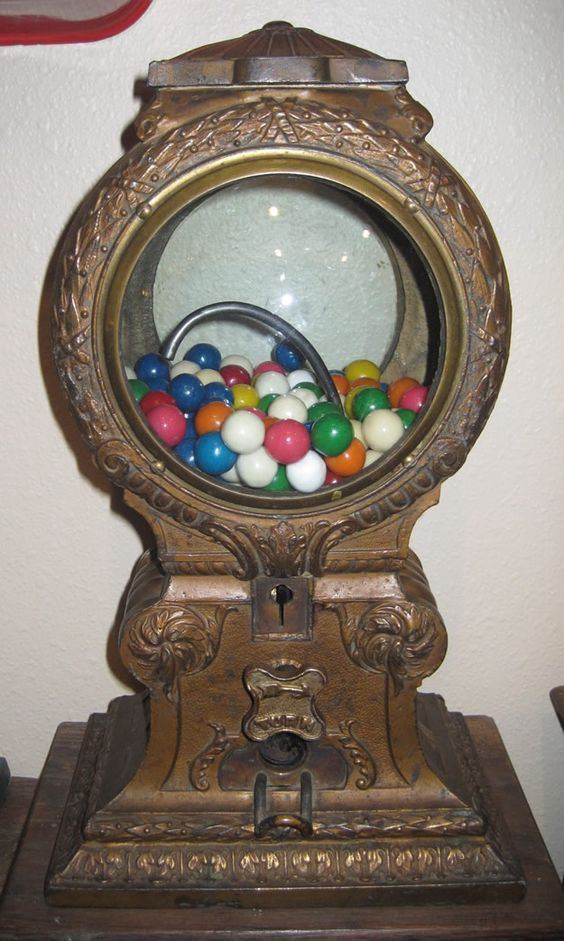
Gumball machines are antiques that look beautiful as part of the decoration of any place, and they have a particular charm that is hard to express.
These endearing collectibles can be a terrific place to start if you want to explore the interesting world of collecting antiques.
The hobby of collecting antique gumball machines can be rewarding and enjoyable, but it is important to learn some fundamentals before buying or selling. When you start collecting these coin-operated machines, you need to know their history and how to identify them accurately.
This article will inform you about its origins, models, values, and how to identify genuine vintage Gumball machines from replicas.
Table of Contents
What is a Gumball Machine?
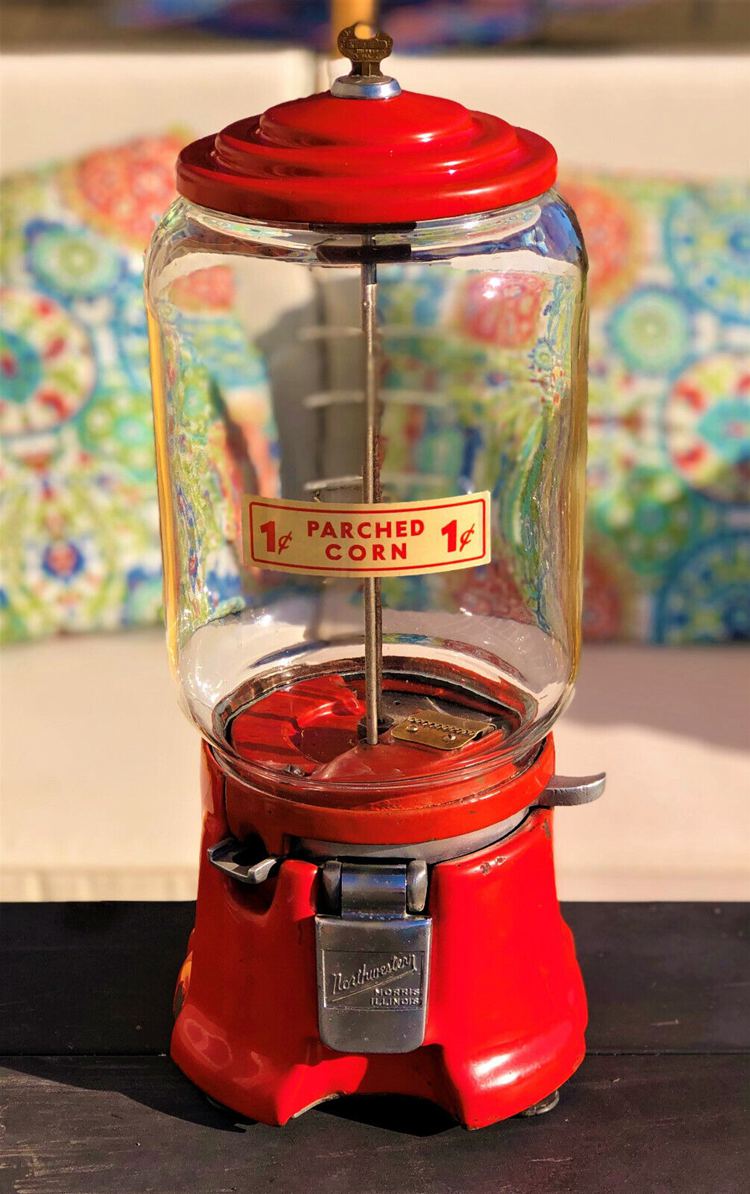
A gumball machine is a type of vending machine that releases little gumballs when a coin is placed. Gumball machines are typically found in public locations like supermarkets, shopping centers, and theme parks, but they are also common in households.
These vending machines offer a variety of colored gumballs with a chewy center and a hard outer shell. From classic fruits to bizarre and fascinating concoctions like cherry cola, pineapple, and even root beer in the USA, each color has a distinctive flavor.
Parts of Gumball Machine
-
Globe
This is the gumball-holding machine’s transparent, rounded top. Globes are composed of glass in replica and higher-end variants. On the other hand, cheap models have plastic globes. The globes are typically circular, although certain retail models may have square globes instead.
-
Base
A gumball machine’s base, which is often red and silver, is arguably the most distinctive component. These are constructed of plastic in some versions and cast metal in duplicates. To keep the globe from tipping over under the weight of the gumballs, bases are typically weighted.
-
Dispensing Ball
The gumball dispensing mechanism is run by the key crank and coin feed, which are both located on the base. There is still a key crank that needs to be spun to get a gumball in plastic replicas that don’t require coins to work.
-
Well
The gumball is caught in a gumball machine’s well. It is typically a small dip or hollow near the tip of an internal funnel that is attached to the globe. Gumballs cannot fly out of the machine because of this.
When and Where Gumballs Were Invented?
The first gumball machines with traditionally flavored tutti frutti gum appeared in the late 19th century. Contrary to popular belief, The Thomas Adams Gum Company really created the first gum machine, not William Wrigley.
These devices, which could be located on train platforms, contained animated characters to make them more enticing. They had a function and were the country’s first chewing gum vending machines.
When Pulver unveiled the first gumball machine in 1907, everything changed. However, the machines didn’t really take off until 1933. Gumballs entered western society as a result of the Northwestern Corporation’s Model 33 machine.
The Ford Gum and Machine Company was arguably the most major effect on gumball machines. A carousel gumball machine with a round form and a twisting mechanism was created by them. Despite being updated, many gumball machines still feature the traditional carousel shape.
History of Antique Gumball Machine
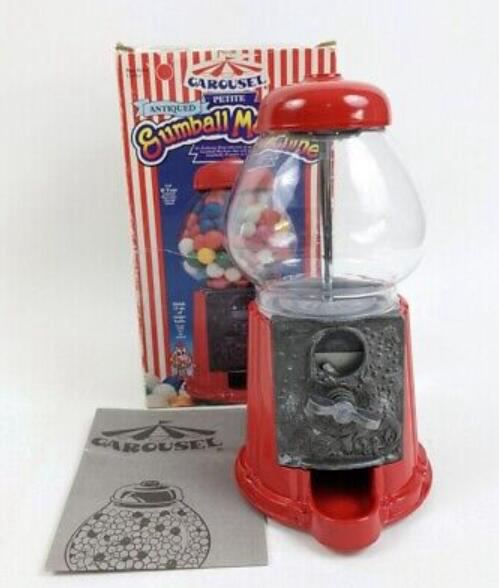
Gumball machines up to 100 years old are regarded as antiquities, according to J. Michael Flanigan of Antiques Roadshow.
Chewing gum is credited as being created in Greek antiquity. The first commercial gum was created by John B. Curtis a few thousand years later. The first patent for gum was then obtained by William Finley Semple in 1869. Thomas Adams released the chewing gum Tutti-Frutti in 1888.
First Gumball Machine Manufacturing
In 1888, Adams created the first gumball machine. His marketing expertise was made clear in 1907 when he put coin-ops on railway platforms, which saw the most foot traffic in New York. Later, Adams Sons and Company unveiled the device that contained gumballs.
The machines that are the most likely to be recognized today resemble cast-iron works of art from the 1920s and the 1930s that were encased with fire engine red porcelain. They had a bowl of glass on top that was filled with colorful gum balls and claw feet to hold them.
Every tenth consumer received a free gumball at the Hawkeye Novelty penny machine in the United States during Prohibition (1920–1933). The Hawkeye was outlawed by authorities because they felt it was too similar to a gambling machine.
Types of Gumball Machines
-
Replica Gumball Machine
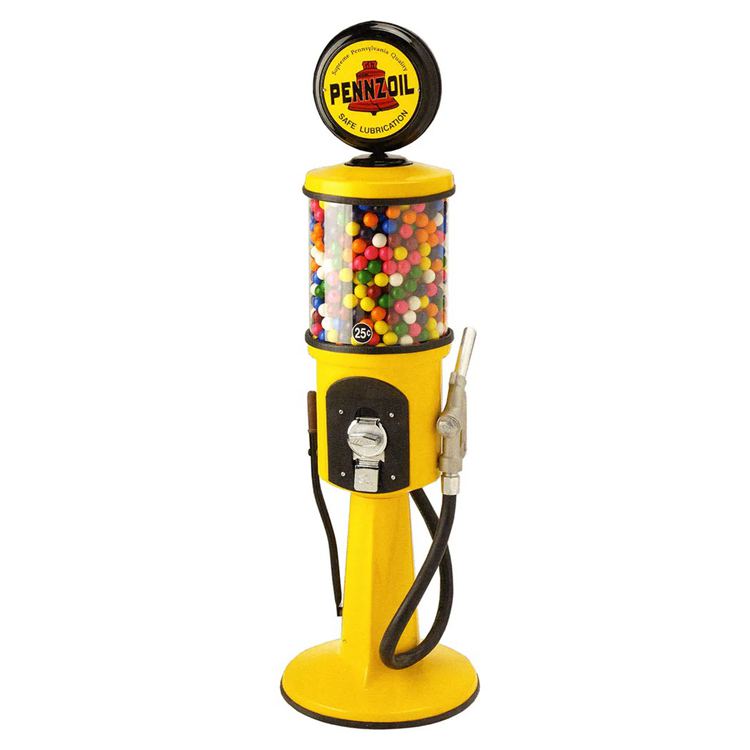
Replica gumball machines typically hold 400 to 600 regular gumballs and closely mimic the conventional units seen in shops. They weigh about 5 pounds and are composed of cast metal and glass. These typically stand 12 to 16 inches tall on tables and are tabletop devices. A replica model is most likely your best choice if evoking nostalgia is your goal.
-
Mini Gumball Machines
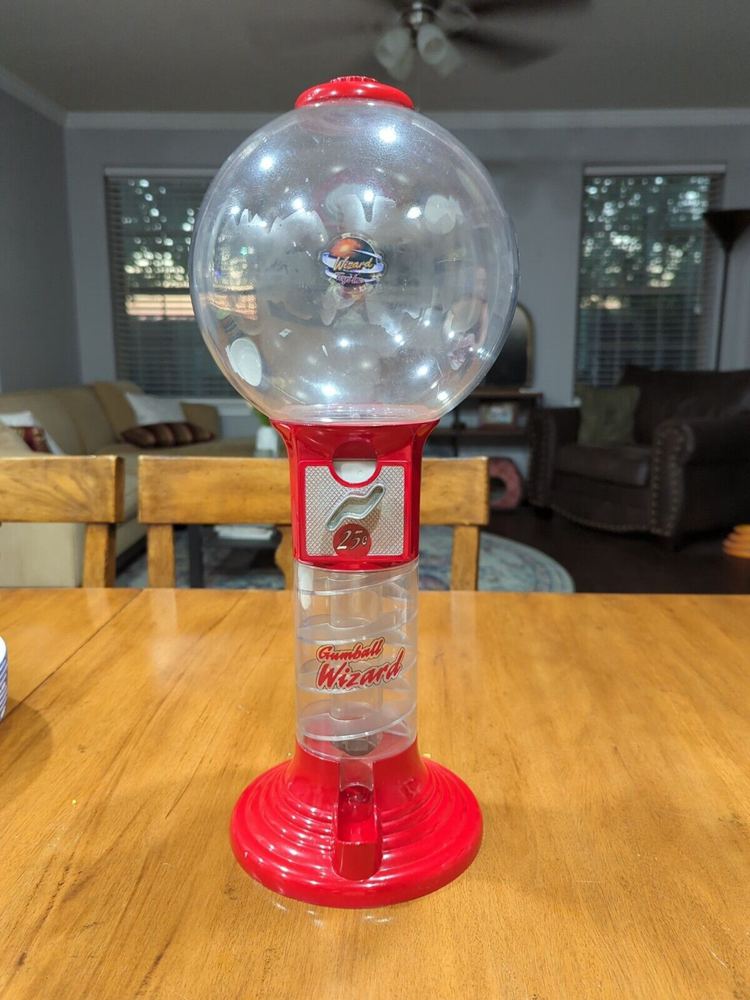
These little trinkets, which are primarily constructed of plastic, range in height from 6 to 10 inches. Although their functioning is typically constrained, they are frequently simple to refill. Gumball machines have a bit more staying power than other favors, especially since they can be refilled and, let’s face it, are a lot of fun.
-
Full-size Gumball Machines
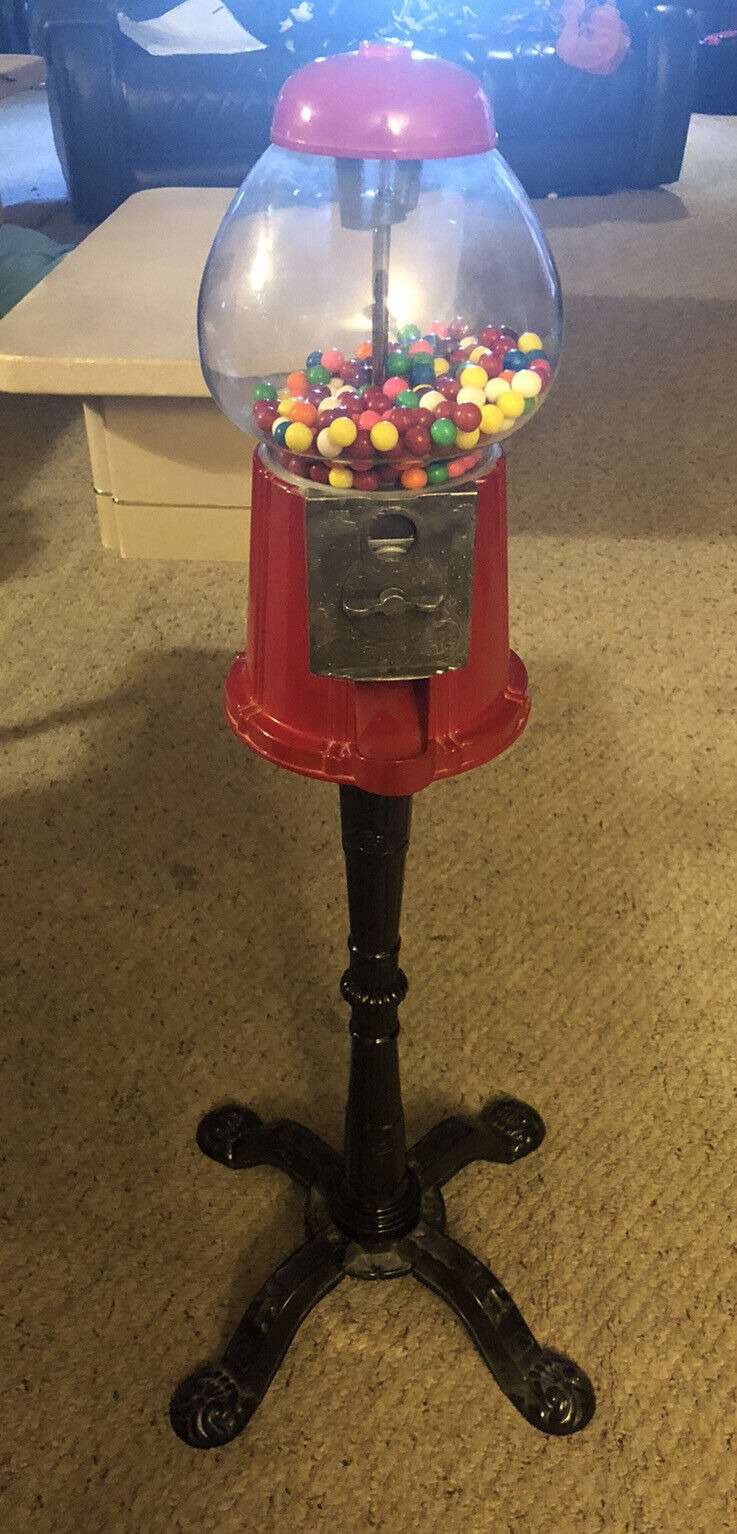
These replicas stand alone and resemble a replica gumball machine with a long, slender leg. They frequently have the same size as tabletop models or are significantly larger. Some full-size gumball machines have two to four connected globes that hold a variety of candies.
Identification of Different Models of Gumball Machines
The Antique Gumball machines are clearly the most sought-after and valuable on the market, according to all experts.
There are other models available, however the ones listed are among the most spectacular and noteworthy.
NORTHWESTERN 33 JR PEANUT MACHINE
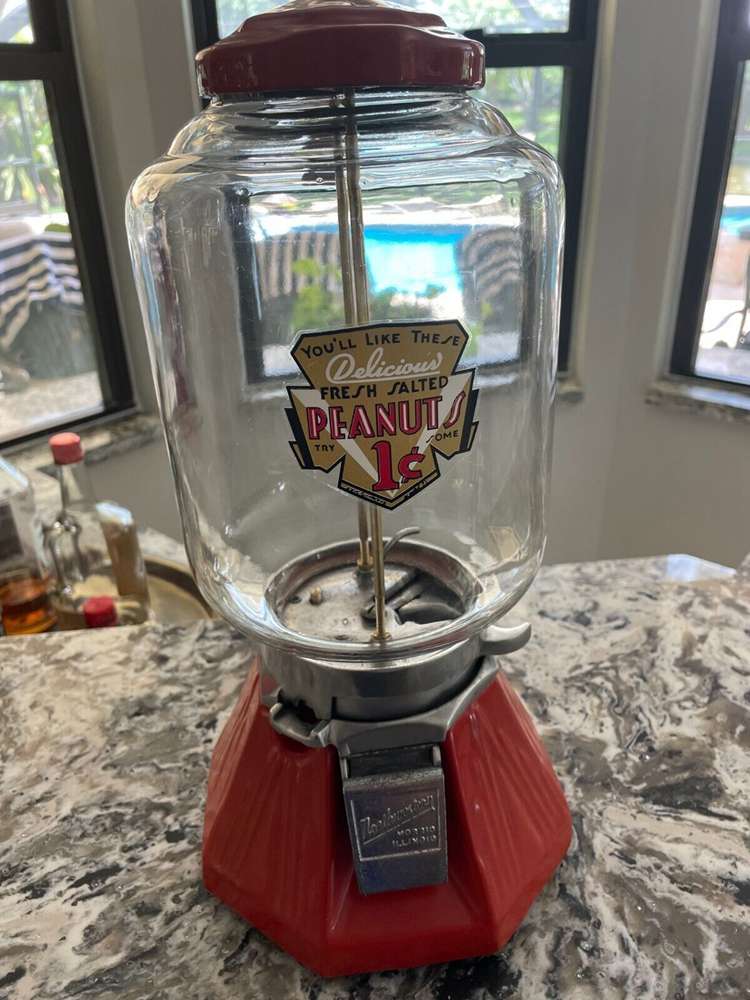
Northwestern Corporation produced this Gumball machine in 1933. For the year it first went on sale, it is known as Model 33. Similar models like the Northwestern Model 60 and 80 are still produced today.
Although it is very similar to the Carousel type, this one has the glass in the shape of a cylinder rather than a ball.
Carousel Gumball Machines
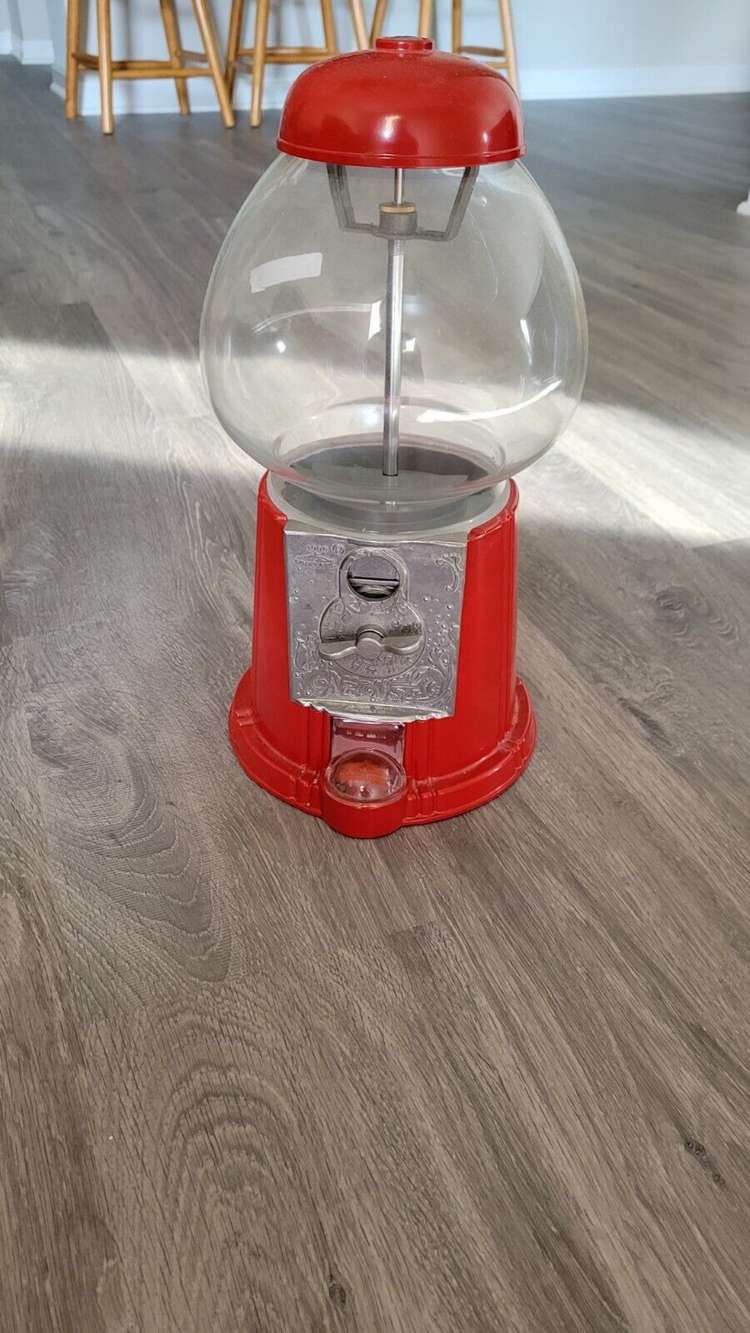
This Gumball machine is the most well-known and emblematic model among others. The Ford Gum Company began making this particular style in 1934, and it quickly rose to prominence.
It was utilized by numerous brands of numerous products as part of their advertising campaigns to print their logos.
Even now, these models are still being made. Although the company still makes its own devices, the market is overrun by imitations like these.
CHIC-MINT GUMBALL MACHINE
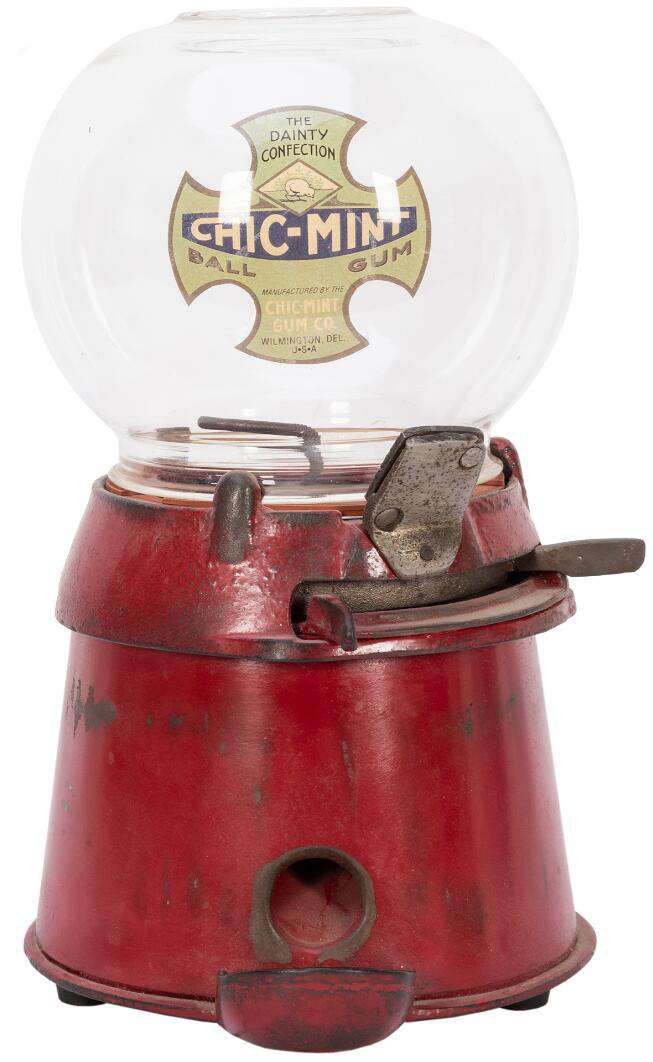
The Ferris, Hass & Co., Wilmington, Delaware’s Perfection Automatic Co., and the Chic-Mint Gum Co. later produced this machine. The same basic machine, with a sheet metal bottom and a cast-iron mechanism, was produced by all three companies. The decal on this machine is also original.
PEERLESS PRODUCT CO. AKA BLUEBIRD PENNY DROP GUMBALL MACHINE
The consumer operates the control rod to move the penny chute after inserting a penny into the machine. The penny is then allowed to fall through after he pulls the lever with his right hand. You would receive a gumball and your penny back if it struck the return. Take note of the chute cover; this variation is rare.
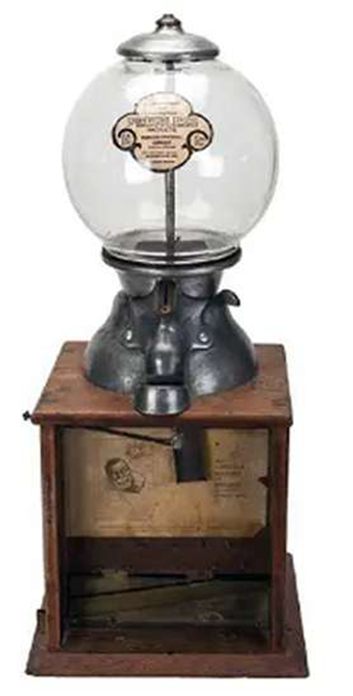
ROTH PANSY GUM MACHINE
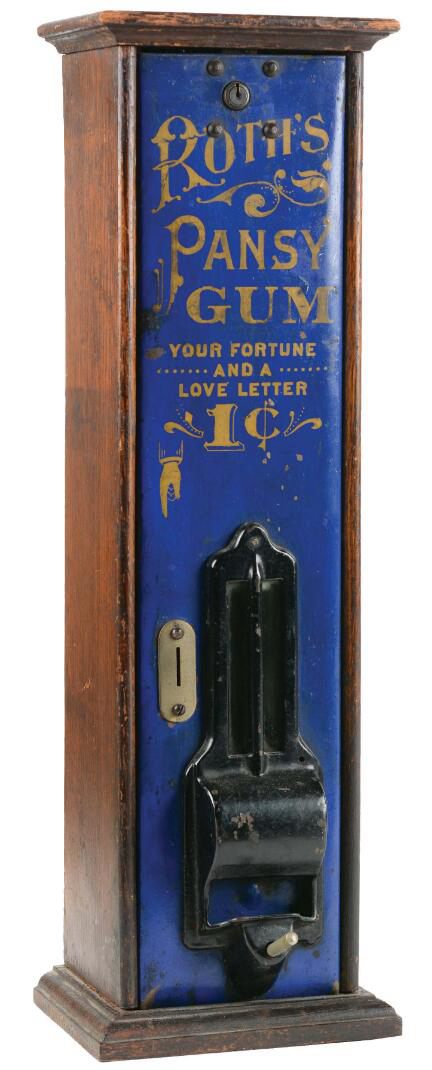
Roth’s Pansy Gum produced this vintage gumball machine sometime about 1905. The writing is inscribed on the cast iron front plate. Push the bottom button after inserting a penny to get a stick of gum.
WRIGLEY’S GUM MACHINE
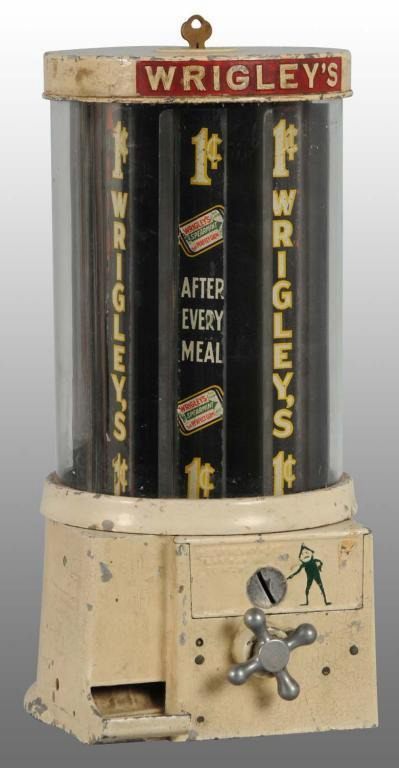
Wrigley’s Gum received 3 different versions from The Hoff Vending Co. Two of the models were tab gum sellers one with a lever, which is the older type, and one with a knob, which is the model that is depicted here, and one was a Lifesavers vendor. Despite having a pot metal mechanism, this model is built of aluminum. A piece of tab gum is yours when you insert a penny.
SCOOPY GUM VENDOR
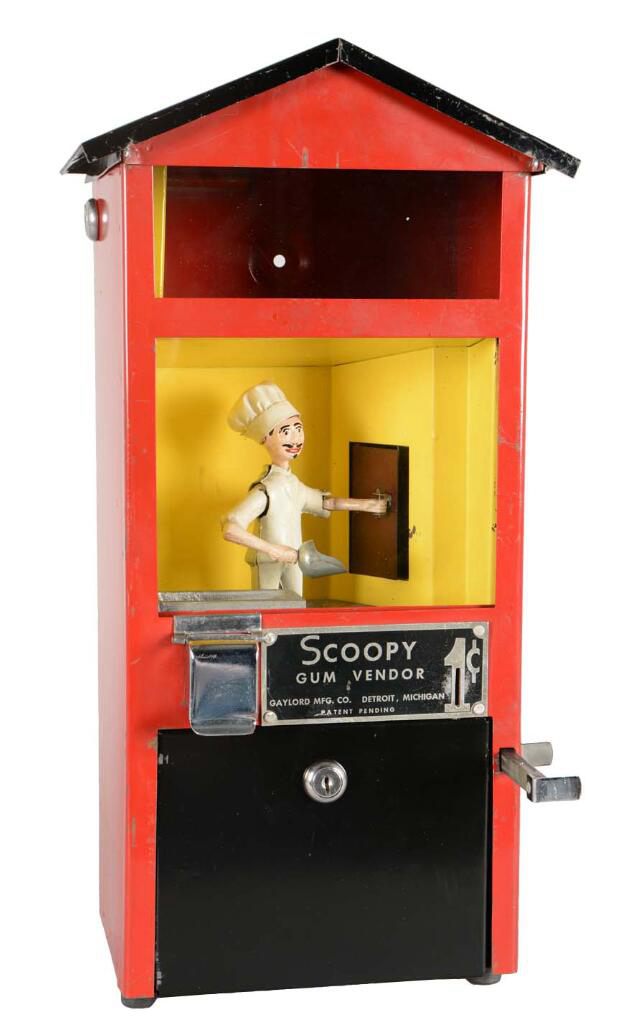
Scoopy Mfg. Co./Harris Gaylord Mfg. Co. produced SCOOPY GUM VENDOR between 1949 and 1955. The machines’ bodies were built of sheet metal and shared the same patent as the previous Maniken Vendor Company (Baker Boy) models despite being produced 25 years later and by a new manufacturer.
Happy Jap Tab Gum Version Gum Machine
Happy Jap Gum Machine was made by White Vending Machine Co. made with cast iron. A stick of gum is delivered via his teeth after inserts a penny and pulls the lever in the mouth corner. The lever in the corner of his mouth is a rare feature of this specific Happy Jap machine.
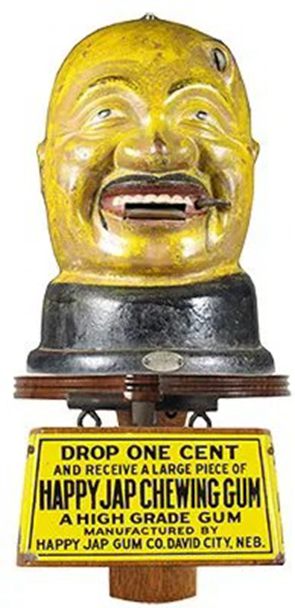
1¢ WOODEN ZENO STICK GUM VENDING MACHINE
The J. N. Johnson Company out of Los Angeles, California is marked on the back of this all-original oak clockwork Zeno chewing gum machine, which also features the original Zeno tin front sign, all original castings, a complete Zeno coin entry with all original mechanism, and the back door with all original instruction label. An excellent addition to any collection of coin-operated machines and a really good all original Zeno stick gum machine.
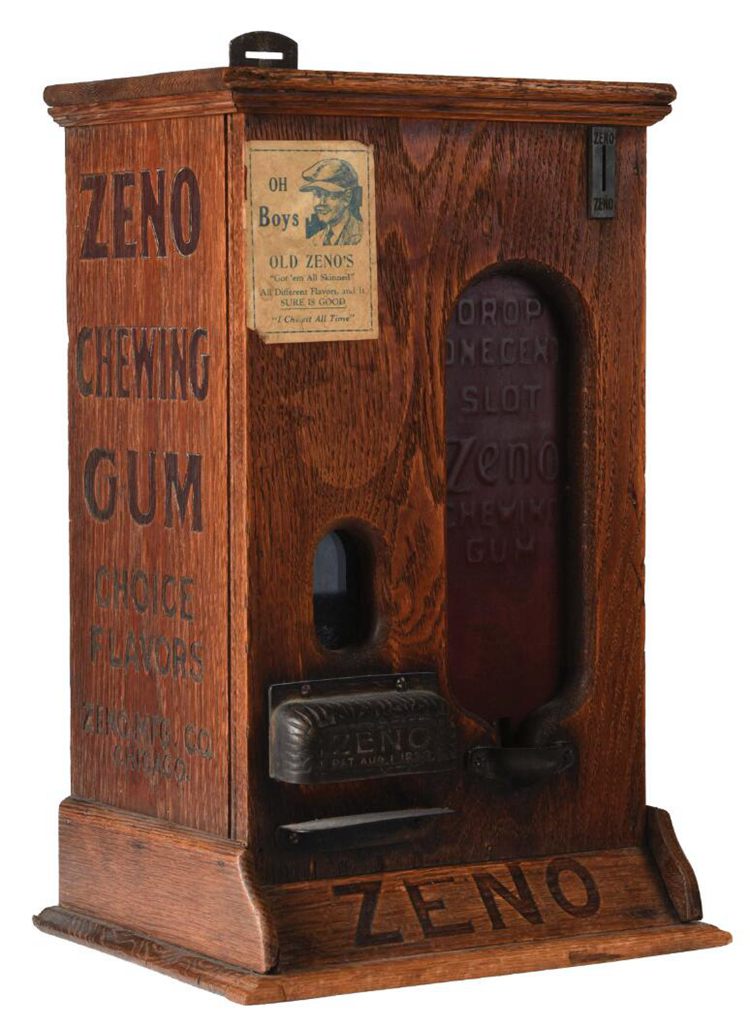
Gumball Machine: Original Vs. Replica
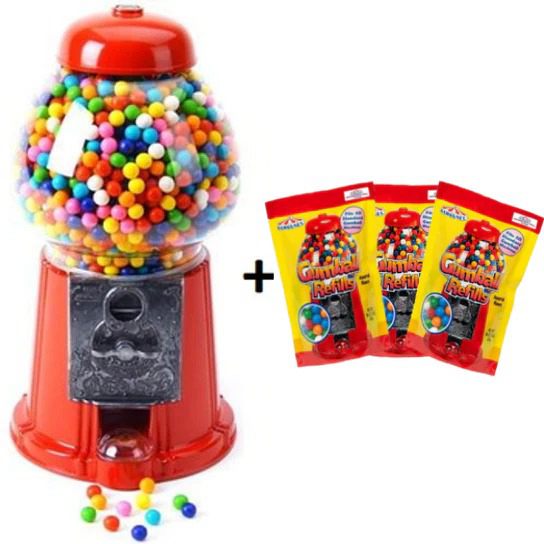
Replicas of gumball machines are widely available since they are still sought-after by collectors and are profitable to produce.
These copies are meant to be sold as the originals in order to deceive buyers into thinking they are authentic vintage gumball machines but, in reality, they are really modern machines that have been given an antique look in order to fetch a higher price.
Because of this, we wish to provide you with the fundamental standards so that you can learn to differentiate a real antique machine from a fake and prevent being taken advantage of by dishonest persons trying to make immediate profits.
Original Vs. Replica
- The original wood doesn’t have the appearance of fresh wood, is unevenly colored and textured, has certain areas of warpage and shape change, has dirt and filth in some corners, and exhibits separations in junctions, edges, and borders. White oak was utilized as the primary wood, while the replica gumball machines contain wood that has been artificially worn to mimic antique wood and has crisp, clean edges as well as smooth and sharp edges. Red oak is frequently used to create replicas, though the type of wood used varies depending on the model.
- The replicas’ metals and metal casings are sharp and clean in detail, but the original Gumball Machine’s metal background is rough and its screws and fasteners appear to have shrunk in comparison to the replicas’ crisp, clear features.
- The replica gumballs’ colors are vivid and lively, in contrast to the original machines’ dreary, fading hues.
Identification of Antique Gumballs Machines
For identification of your vintage Gumballs machines, must consider these factors:
-
Investigate the Wood
The replicas machines were made primarily of red oak, as opposed to the majority of the actual machines, which were mostly made of white oak.
Look for features like minor deformations and dirt and grime buildup in joints and fissures.
You’ll see that by intentionally forcing the wood to wear down, phoney machines mimic the effects of ageing. There is no accumulation of dirt or filth at the wood joints, and the edges are sharper and cleaner.
-
Examine the metal and metal case of the machine
The inscriptions and engravings that adorn the gumball machine best represent the originals. The moulds are not of the highest quality, despite the fact that the imitations can clearly see numerous flaws in the metal.
Because of this, the pieces are less finished and have more rudimentary embellishments than truly antique pieces.
When compared to genuine parts, fake parts typically exhibit evidence of shrinking. It’s also a good idea to look at the machine’s screws or bolts because fake parts typically have brand-new, shining screws.
-
Thoroughly Analyze the inside details of the machine
The majority of the information that can reveal a false duplicate can be found inside the machines, so it is important to always look inside them.
Make sure that any wooden components of the machine are not painted if they are; authentic versions did not have painted interiors, although replicas do.
Check the inside of the device with your nose for additional helpful advice. If they’re fake, they’ll smell chemically and like enamel paint. whereas the smell of dust and possibly mould will always be associated with ancient machines with wooden parts.
How to Find the Value of your Antique Gumballs?
Depending on the size, materials, and quality, gumball machines range in price from $8 to $300. The value of gumball machines has not decreased over time. They are simple to restore and excellent for use at home and as room décor.
-
Inexpensive
Gumball machines in budget price can range in price from $8 to $15. Most of them are made of plastic, and very few of them accept gumballs that are the regular size. They are primarily used as gag gifts or favors due of their mediocre quality.
-
Mid-range
Gumball machines fall into this price bracket, costing $20 to $80. Some of them will have plastic parts and metal bases, while others, like classic models, are constructed of glass and metal.
-
Expensive
Top-of-the-line gumball machines are frequently well-built freestanding units, which can increase the price to as much as $100 to $300. They are frequently used in retail settings and have one to three globes.
In order for you to have an idea of its market value, we’ve left some pricing here:
-
Star Pepsin gum machine sold for $27,600
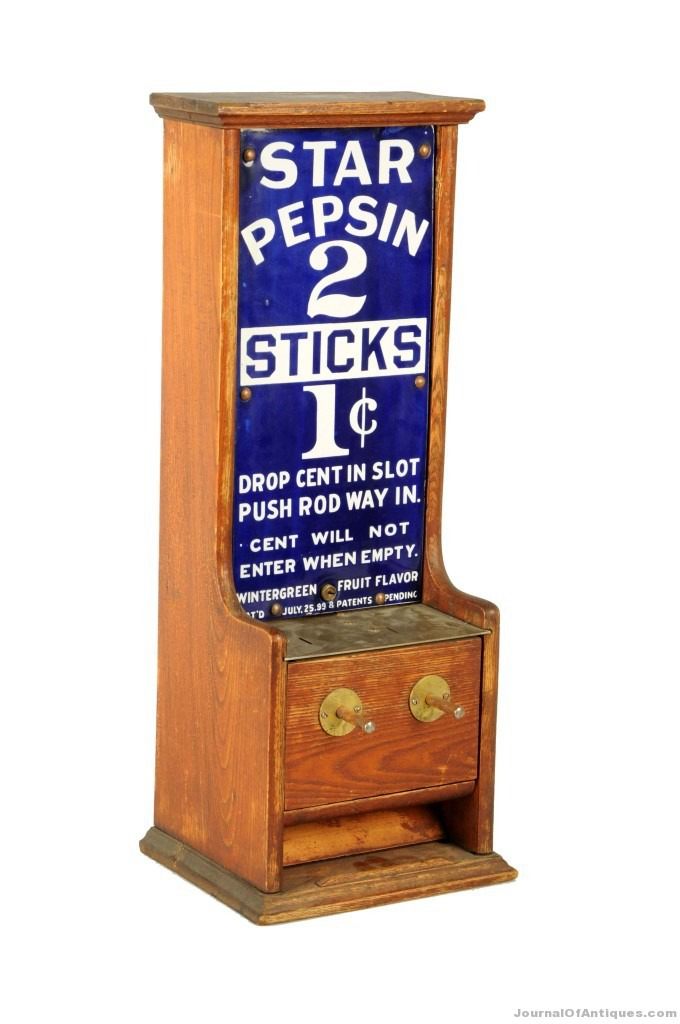
-
1920/30s Pulver Chewing Gum Porcelain Vending Machine Stop & Go Policeman Red sold for $780.00
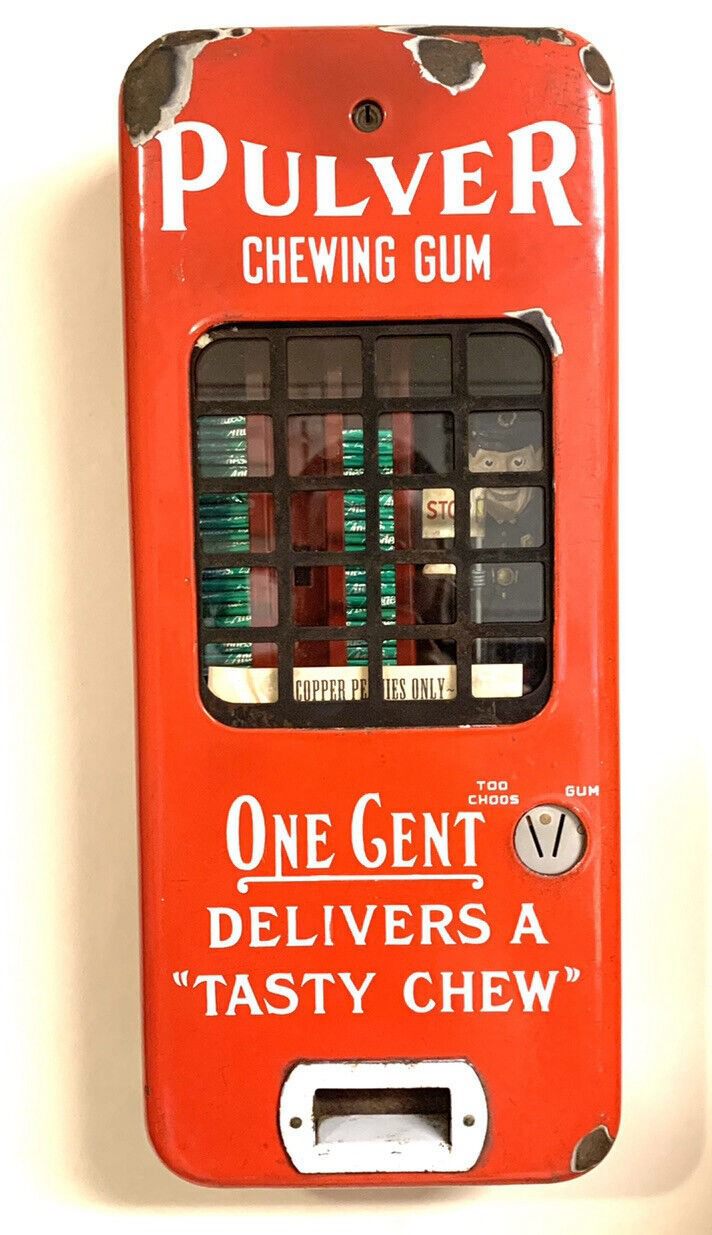
-
Vintage Nice Old Oak Acorn 1 Cent Candy Peanuts Gumball Gum Vending Machine sold for $260.00
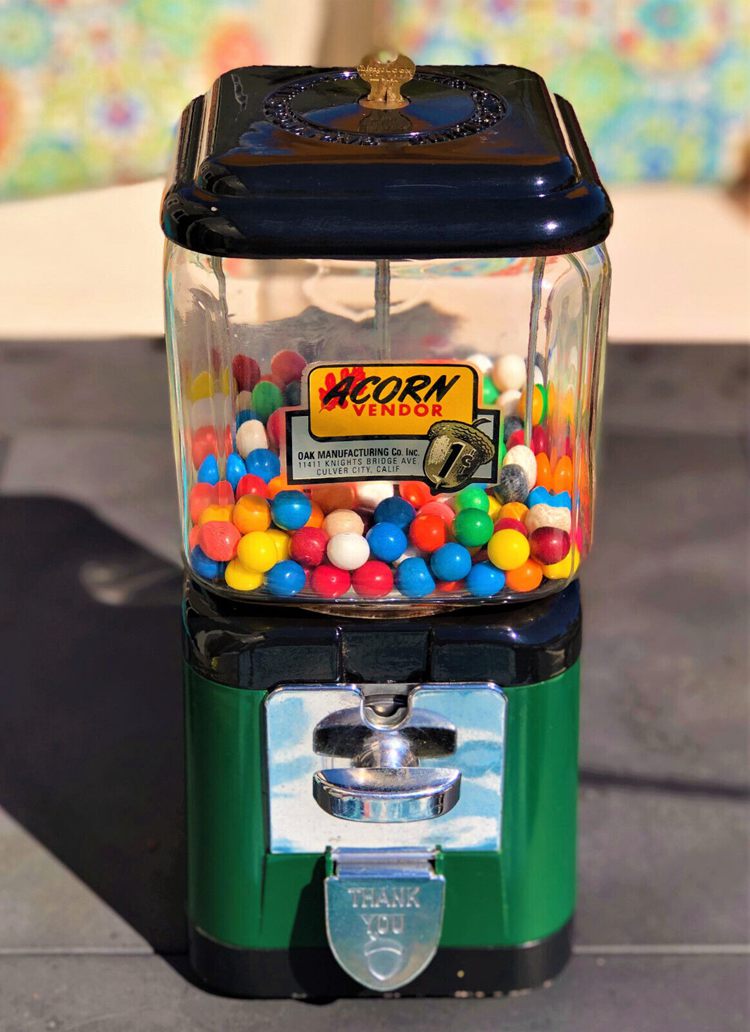
-
Vintage Columbus Star 1-Cent Gumball or Peanut Vending Machine sold for $577.00
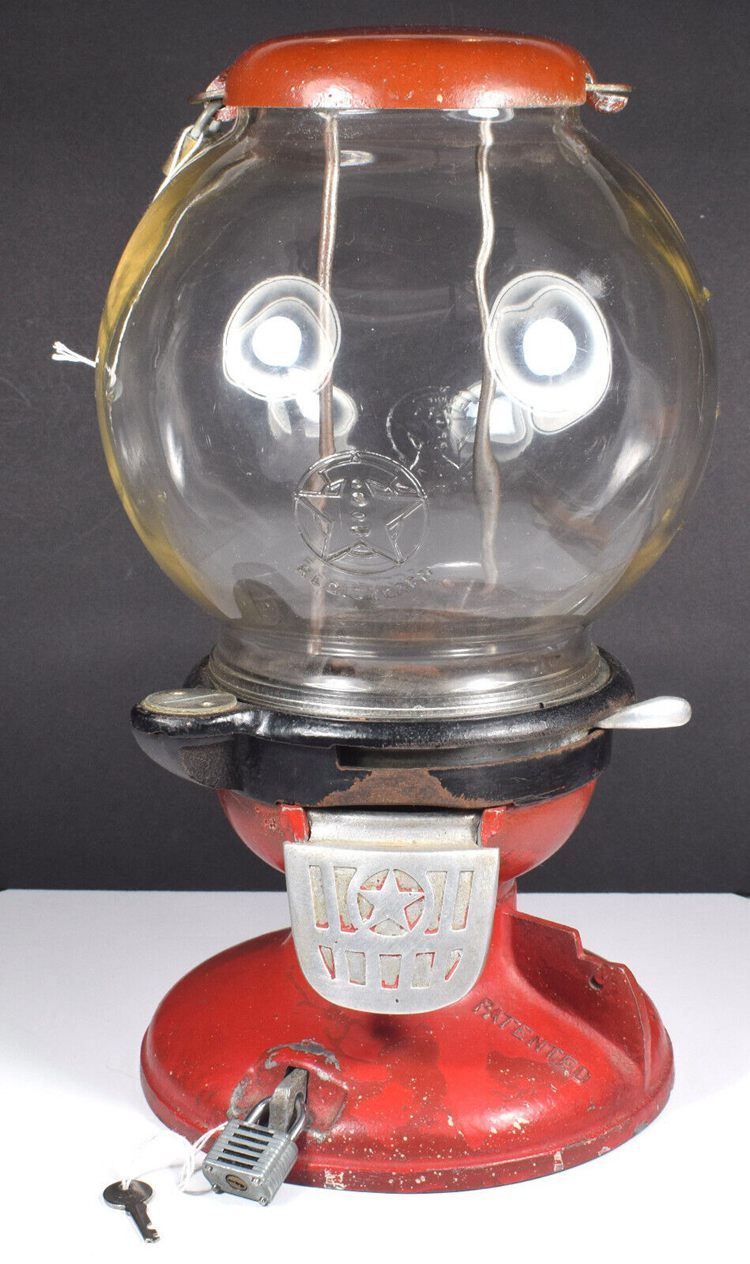
-
1 CENT GUMBALL MACHINE – Vintage, Ford Gum w/ Glass Globe, Topper, & Decal sold for $105.99
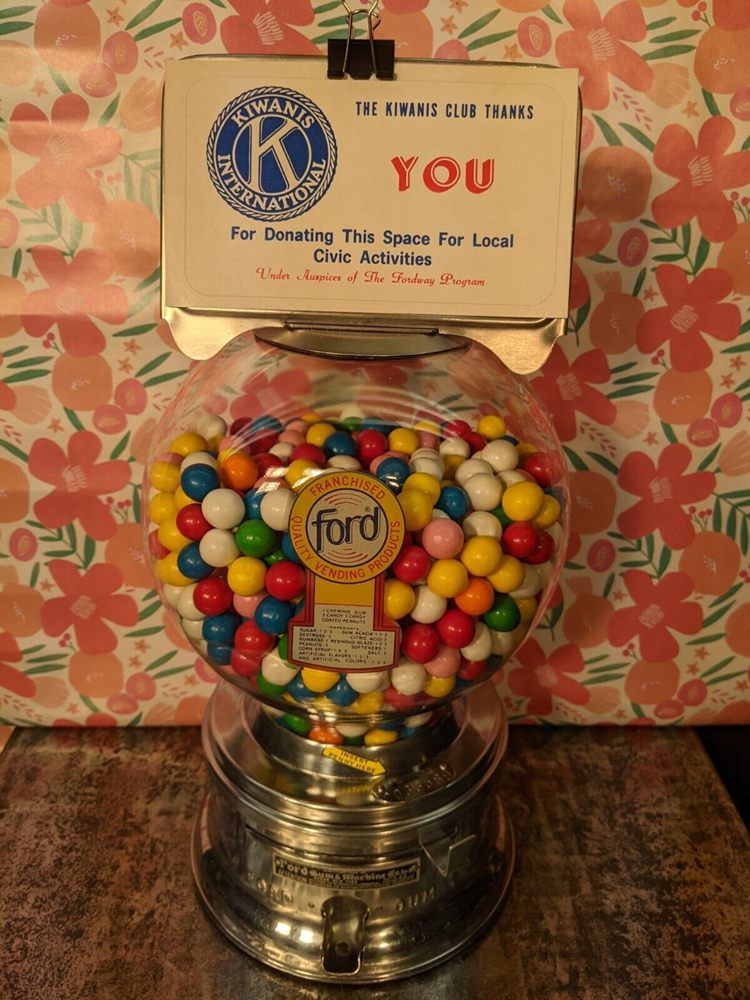
-
Antique Coast Vending Gum Candy Basketball Machine 1 Cent sold for $214.48
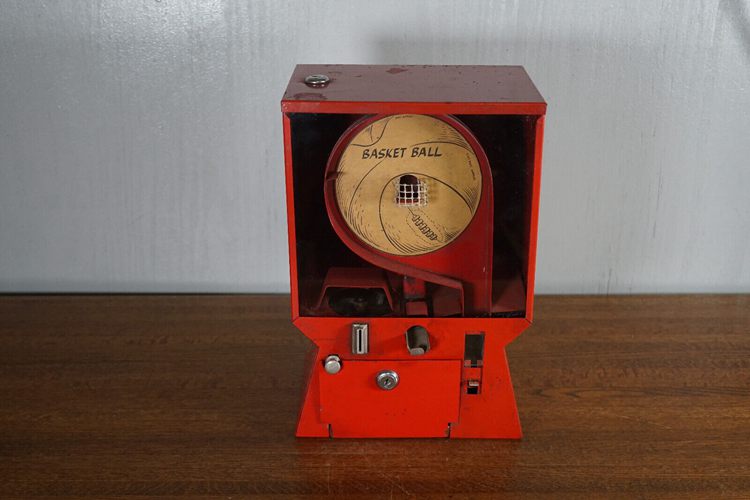
Where to buy these Antique Gumball Machines Online?
Searching online is your best option if you need to find one immediately. Consider the following sites:
e-Bay – The Antique Gumball Machines of your dreams can be easily found on eBay, one of the greatest sites to find beautiful Antique collectibles. It’s also ideal if you’re considering selling because they provide a very user-friendly e-commerce feature and can reach a sizable global audience.
Etsy – Since people frequently discover these different Vintage Gumball Machines items in their grandparents’ homes across the nation, internet marketplaces like Etsy are among the greatest places to find a ton of these pieces on sale.
Other Auction Sites – Anywhere in the world, there are auction houses, and each one is unique in terms of the type of goods it specialized in, the price range, the types of people it serves, and the way it does business. Liveactioneers and other auction sites where you can find your vintage items.
Tips for your Antique Gumballs Machine
- Your gumball machine can be used to store coins. A gumball machine can still serve as a fun coin bank if you don’t enjoy chewing a lot of gum.
- Over a sink or basin, refill the machine. Although it’s simple to pour gumballs or candy into the machine, cleanup time can be extended if there is a spill. If you fill the machine in a secluded area, you can reduce the spill radius and avoid having to grovel on the floor or vacuum up candy fragments.
- One can be given as a housewarming present. Any home would benefit from having a gumball machine. They can be added by the recipients to a kitchen, cellar, or playroom.
- Pick your topics carefully. Even though chocolate sweets are great in gumball machines, if the space where it is located isn’t climate-controlled, you’ll get a globe full with melted chocolate.
Frequently Asked Questions
-
Does my gumball machine have a way I can turn off the coin mechanism?
This is achievable with most models, depending on the machine. To avoid the currency feed, you’ll need various tools and internal modifications. The option to modify the denomination to accept coins with lower values is available on some machines that don’t have it by default.
-
What were the original components of gumball machines comprised of?
A gumball machine typically consists of a clear, gumball-filled spherical (originally made of glass, but now more frequently of plastic) perched on top of a metal base.
-
What shape did the first gumball machine have?
The modern-day gumball machine, with its spherical glass (or more frequently, plastic) dome or sphere, was first made available in 1907. Most likely Thomas Adams Gum Co., a manufacturer of some of the most well-known chewing gum products, was the one who came up with the original design.
-
How much money can a gumball machine produce?
Some bulk gumball machines can bring in up to $350 a month, while others barely make $2. According to Vending Times Magazine, the average daily earnings for gumball machines across the country is $1.
Summary
The most important aspect that will contribute to your success, whether you’re an experienced or newbie collector of antique gumball machines or any other antique or vintage object, is information. Keep your attention on one era, style, or manufacturer at a time when you first start out until you are confident enough to go on to the next.
Learn how to spot imitations that pass for authentic items, make use of information, networking, join clubs, and don’t be hesitant to inquire.
Out Takeaway
If you recently bought or are thinking about purchasing an old gumball machine. Or perhaps you discovered some antique gumball machines in the new estate’s basement. Regardless of context, reading our guide on identifying and valuing them will help you determine how much a vintage gumball machine is worth. However, if you want to completely appreciate the worth and value of your vintage gumball machines, we strongly urge that you see a competent appraiser.





![Where To Sell Antique Furniture In 2022 [Ultimate Guide]](https://www.jacquelinestallone.com/wp-content/uploads/2022/09/Etsy-Your-Place-To-Buy-And-Sell-All-Things-Handmade-600x450.jpg)


